When one sees a traditional wedding in Maharashtra, the first impression that springs to mind is “Simple is lovely.” Marathi weddings are vibrant and full of exciting rituals that are sure to add zest to the experience.
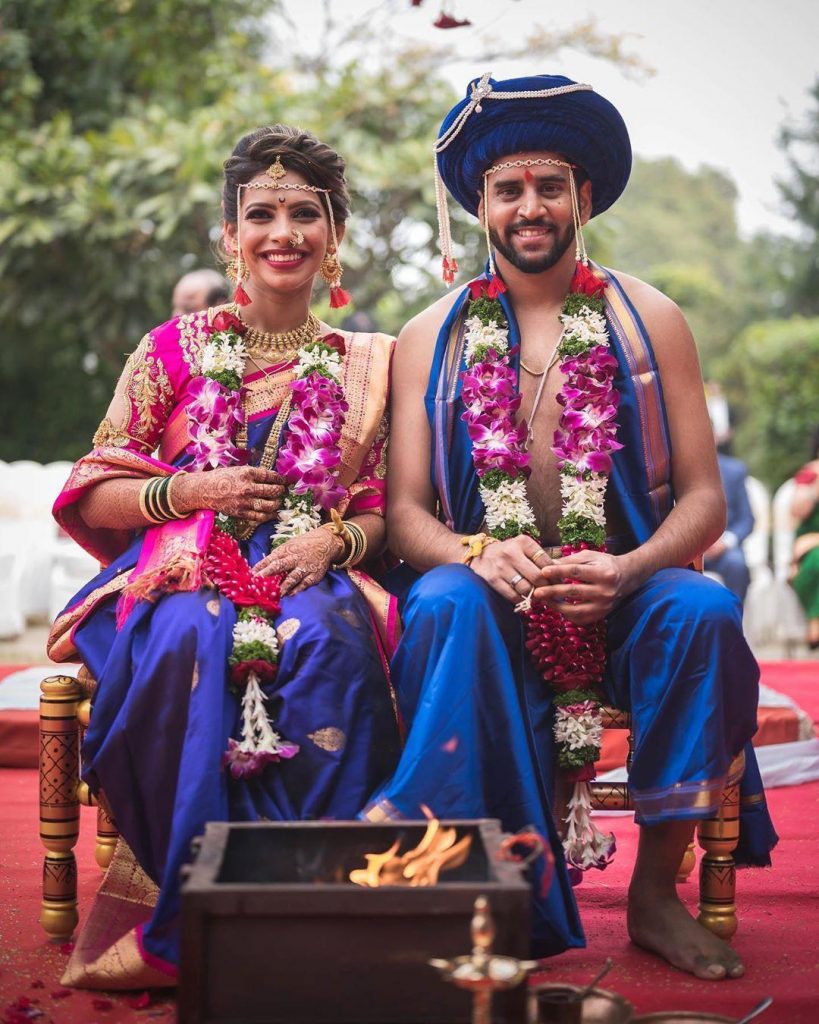
Bathed in the warm hues of saffron, green, and gold, these weddings captivate your senses with an unmatched cultural splendor. Rooted deeply in the earthy ethos of Maharashtra, every ceremony, from the Sakhar Puda (sugar packet) ritual to the vivacious Antarpat ceremony, unfolds like a beautifully choreographed performance, adding an irresistible zest to the proceedings.
Prepare yourself for a captivating journey as we delve into the heart of these vibrant celebrations, where every ritual is a vibrant symphony, a testament to the rich cultural heritage of Maharashtra. From melodious nuptial songs to the tantalizing aromas of traditional Marathi cuisine, every moment of a Marathi wedding is an enchanting spectacle that truly encapsulates the magic of this extraordinary culture.
Maharashtrian wedding rituals list can vary from community to community within the region, but some general traditional ceremonies are time-honoured and followe everywhere.
Pre-Wedding Rituals – Maharashtra
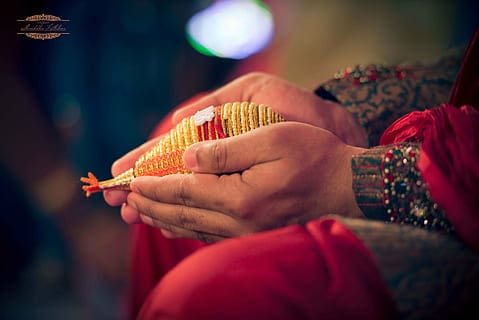
- Sakhar Puda – One of the earliest rituals that marks the start of the wedding process is Sakhar Puda. It’s similar to a traditional engagement ceremony. It usually takes place a few days before the wedding. The two families get together, and the groom’s mother presents the bride with a saree, jewellery, and a packet of sugar, or Sakhar Puda, as a sign of her welcome into the family.
- Muhurt Karane– The family priest determines the exact date and time of the wedding, and wedding festivities begin at both houses by asking five married women, or ‘Suhasanie,’ to participate on a pre-determined lucky day a few months before the wedding. The women pound turmeric or halkund to be used later in an iron pestle laced with mango leaves. They prepare sandage and roll out papads. Following the rites, the bride’s side often hosts a rukhvat — a display of the bride’s handmade decorative and food items.
- Kelvan– A puja is offered to the family deity by both the bride and groom’s sides a few days before the wedding, with their own relatives and friends in attendance. The Kelvan is the name for this ritual, which is usually followed by a lunch.
- Halad Chadavane is a pre-wedding ceremony that takes place the day before the wedding. The same five Suhasinis use the turmeric pound at the Muhurt Karane ceremony. They use mango leaves to apply the turmeric paste to the bride’s head, shoulders, hands, and feet, as well as the groom’s. The ceremony is held first at the groom’s home, after which the leftover turmeric paste is delivered to the bride’s home and applied on her.
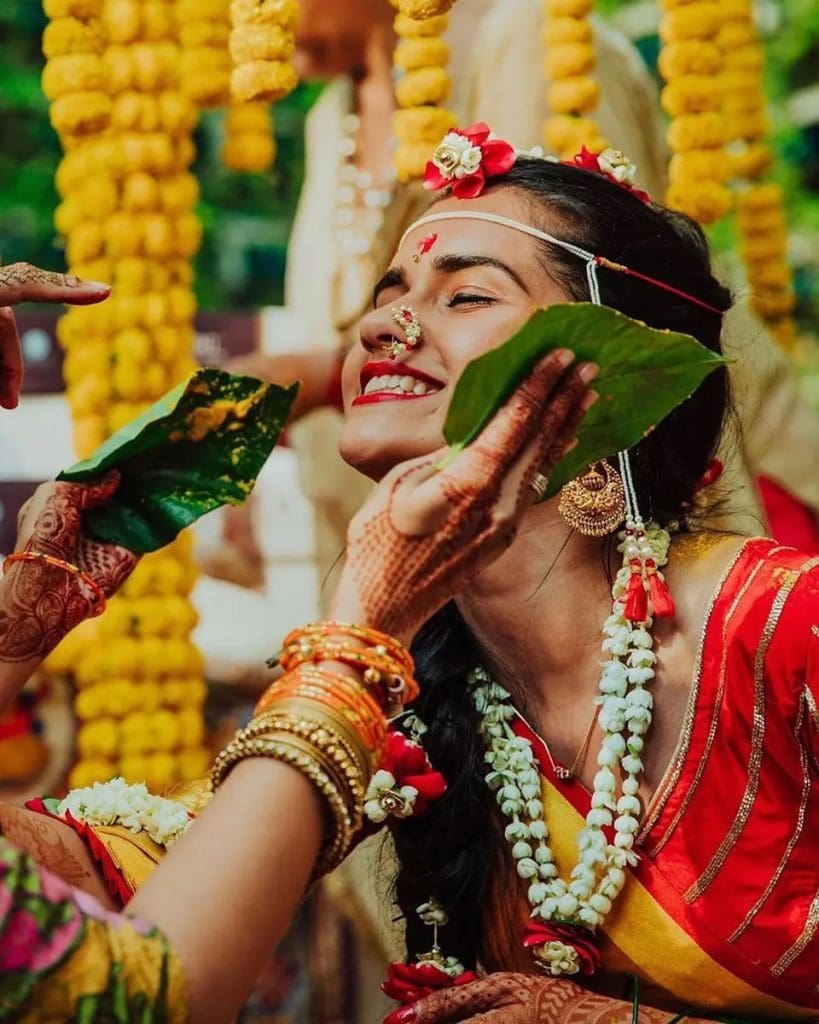
Wedding Rituals – Maharashtra
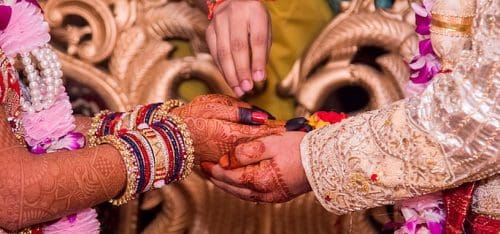
- Ganpati Puja, Devdevak and Gurihar Puja – The wedding day begins with Lord Ganesha‘s adoration, as it does with many other significant Maharashtrian celebrations. Ganpati Puja is done for the couple’s prosperous future. Devdevak then invites the family deity to the wedding Mandap. The bride, clad in her bridal gown, worships the goddess Parvati for a successful life at Gurihar Puja. The bride’s maternal uncle presents her with rice, which she subsequently delivers to the Goddess.
- Antarpat – The groom now enters the mandap wearing a customary cap or turban, the mundavalya, and sits at his allocated spot on the mandap. The Antarpat is a garment that is draped in front of the groom to keep him from seeing the bride.
- Sankalp – The Mangalashtakas, or sacred wedding vows, are chanted by the priest. Her maternal uncle leads the bride to the mandap. The Antarpat is withdrawn, and the couple can see each other for the first time. They exchange garlands and are showered with akshatas (rice that has not been broken).
- Kanyadaan – The groom’s father then offers his daughter to him, along with his blessings, so that they might begin a life of Dharma, Artha, and Kama. The groom takes his blessings and declares that he is gaining love in exchange for love, and that the bride represents Divine love that descends from Heaven and is received on Earth.
- Saptapadhi – The couple encircles the sacred fire seven times while conducting the Marathi marriage rite of Saptapadi, saying out loud the seven wedding vows.
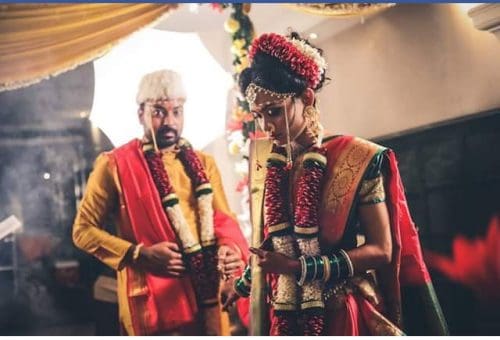
- Karmasamapti – The pair idolises and performs the Laxmi Pujan until the fire is extinguished. The bride is then given a new name by the husband. Ultimately, the bride’s brother tweaks the groom’s ear to remind him of his marital responsibilities, and the couple accepts everyone’s blessings.
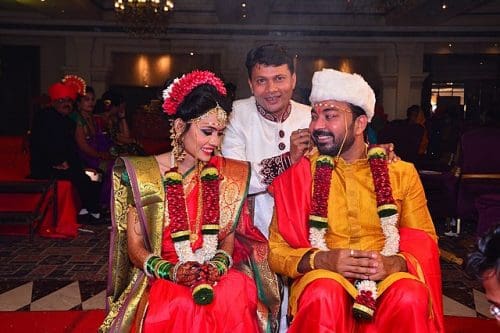
Post-Wedding Rituals – Maharashtra
Marathi rituals after marriage are sentimental and soft in nature and more of a farewell and home-coming welcome in the ceremonies,
- Varat – After the wedding ceremonies are completed, the bride bids a sorrowful farewell to her family and is brought to her husband’s home. Even during Gaurihar Puja, the groom picks up Devi Parvati’s silver idol. The Varat pertains to the bride’s departure from her paternal home and arrival at her husband’s home.
- The first ceremony following a wedding is Grihapravesh. The new couple is embraced by the groom’s mother, who washes their feet with milk and water. Following that, the bride is requested to enter the house by knocking over a glass of rice that has been placed at the entryway. With their right foot, the pair enters the house.
- Lastly , a reception party is held, during which the newlywed couple meets and greets all of their family and friends while delectable cuisine is served. The bride wears a saree and jewellery given to her by the groom’s family, while the groom wears the bride’s family’s outfit.
Wedding Attires – Maharashtra
Again, for wedding, the Maharashtrian groom wears a modest white or beige cotton kurta with a white Kanche or Dhoti with a thin border. They wear a crimson or gold-colored ornamental piece of cloth across their shoulders. They may wear a pheta turban or the customary white Gandhi style cap on their heads.
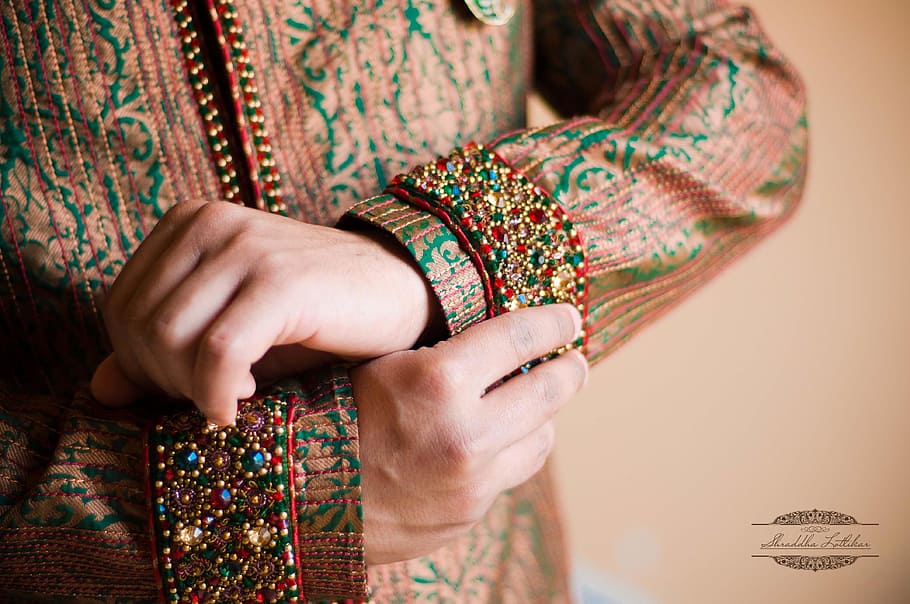
In traditional Maharashtrian trouser style, the bride wears a silk saree with ornate gold borders in vivid colours. Yellow or marigold with green or purple borders are the most popular colour combinations. The saree might be Paithani, which measures roughly 6 yards, or a traditional Nauvari saree, which measures 9 yards.
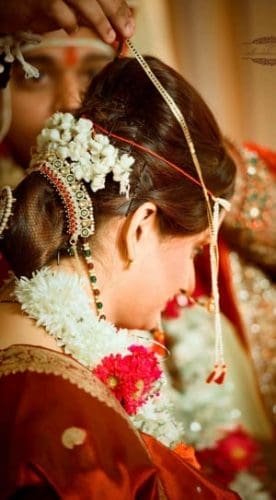
Green glass bangles or Choodas, mangalsutras with two hollow gold cups at the centres, Thusi or traditional necklaces, the classic Maharshtriannath, and Vaaki or armlets are all worn by Maharshtrian brides. Her forehead is adorned with a moon-shaped bindi, which is distinctive of Maharashtra.
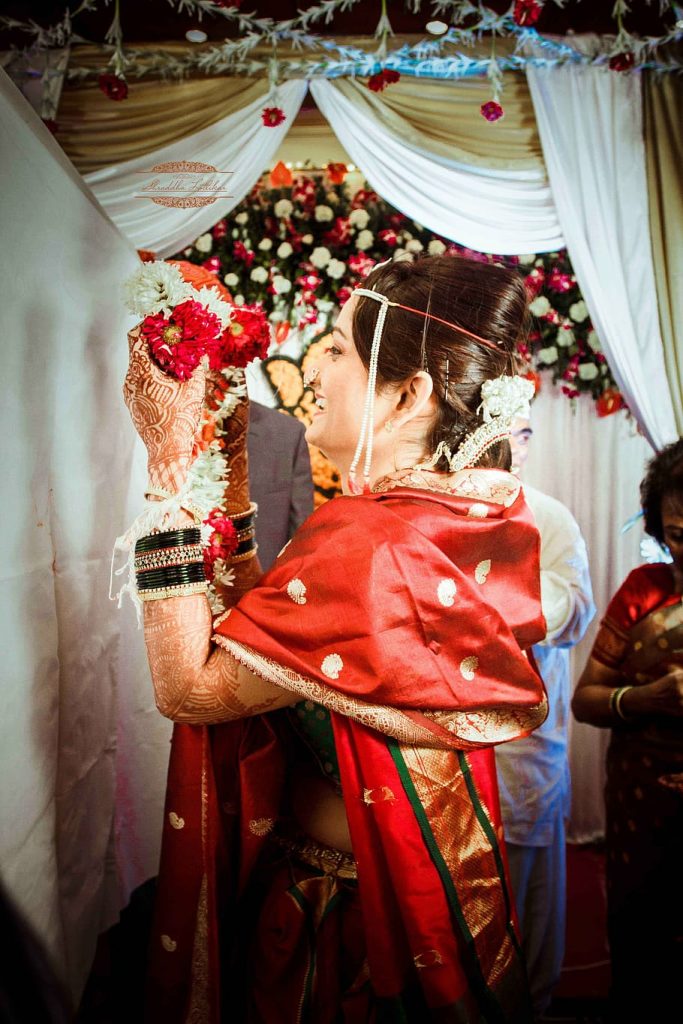
A headband called as ‘Mundavalya’ is worn by both the bride and groom. Two rows of pears dangle down from the headband in front of the ears, and two strings of pearls are knotted horizontally across the forehead.
- Vangi Bharli (Stuffed Eggplant) – When it comes to deciding on a Maharashtrian meal menu, this dish is at the top of the list. You can include this dish in your main course menu and rest assured that your visitors will be licking their fingers. The meal is created with a stuffing of tomatoes, onions, Indian spices, and herbs stuffed in brinjals and is popular throughout Maharashtra.
- Pandhara Rassa – White curry is known as Pandhara Rassa in Marathi. It’s a dish that even non-vegetarians enjoy. This meal is produced with mutton and gravy that has been patiently cooked with the particular ingredient of Kolhapuri masala, as well as other Indian spices and herbs.
- Masala Bhaat – Masala Bhaat is Maharashtra’s equivalent of pulao, and it’s popular throughout the state. You will not be upset if you include this in the rice area of your wedding food menu. It’s a vegetable-and-spice-based dish. The Garam Masala is the primary ingredient that creates the magic and provides it a smoky flavour.
- Poli Puran – Puran Poli is a typical Maharashtra dish that is eaten at weddings and celebrations. It’s a flatbread with a delicious lentil paste packed inside. It is well-liked by all and can be served with ice cream.
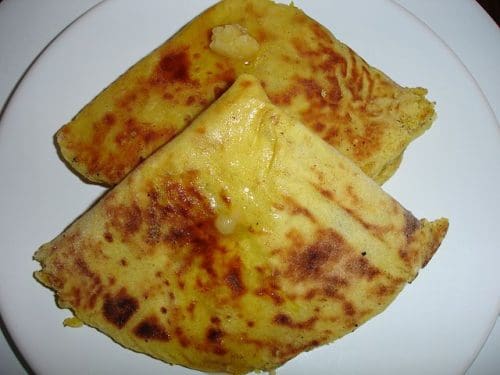
- Amrakhand – Amrakhand is an absolute must-try dessert. Curd, sugar, almonds, pistachios, saffron, and green cardamom are used to make this dish. The Mango Amrakhand is a different variation to consider.
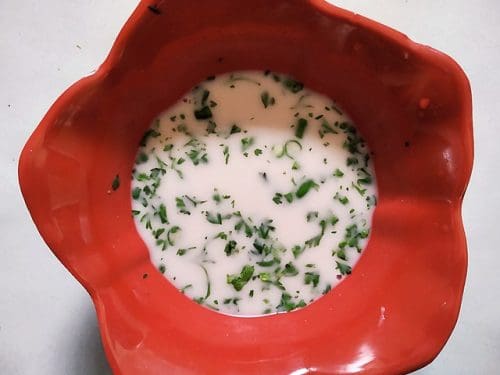
- Kadhi Sol – This is a famous drink in Maharashtra and Goa as well. It’s commonly served with rice or as an after-dinner drink. Coconut milk and kokum are used to make it
- Aluvadi – Aluvadi is a spinach or fresh taro leaf-based deep-fried meal. It’s a great appetiser to provide before your guests dig into the main course. It has a tart and sweet flavour.
- Kothimbir Vadi – In Marathi, kothimbir vadi means coriander, and it is one of Maharashtra’s most famous meals. One can serve this meal with a dollop of green chutney on the counter.
An extraordinary celebration of life and love
In the grand finale, a Maharashtra wedding is nothing short of a mesmerizing spectacle of love, unity, and cultural richness. The symphony of rituals, from the spiritual vibrance of the Antarpat ceremony to the delightful resonance of Mangalashtak, weaves a tapestry of unforgettable moments.
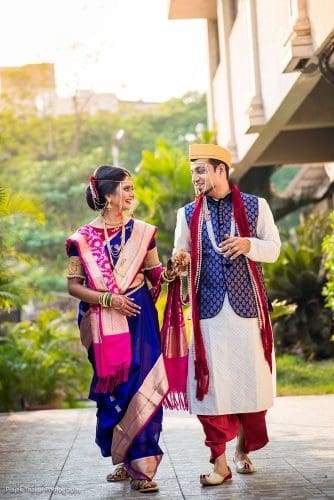
Marathi weddings celebrate not just the coming together of two individuals, but also the glorious cultural legacy passed down generations. The scents of time-honoured cuisine, the rhythm of traditional nuptial songs, and the shimmering colours of bridal attire all come together to create an experience that reverberates with the unique magic and charm of Maharashtra.
This extraordinary celebration of life and love is, indeed, a testament to the vibrant cultural ethos that defines the Marathi community. This vivid tableau of rituals, traditions, and emotions, beautifully encapsulates the true essence of a magical Maharashtrian wedding.
Read More: Lifestyle, Weddings, Wellness



